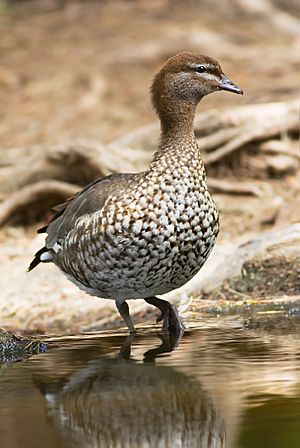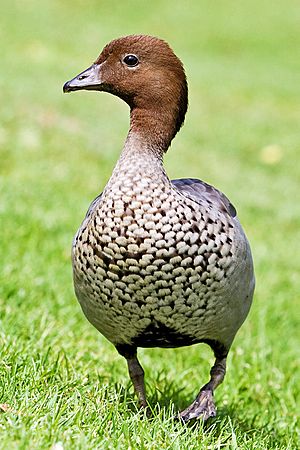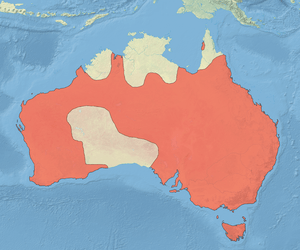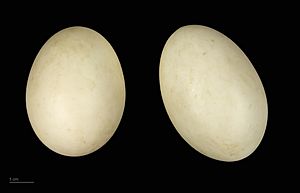Australian wood duck facts for kids
Quick facts for kids Australian wood duck |
|
|---|---|
 |
|
| Adult female | |
 |
|
| Adult male | |
| Conservation status | |
| Scientific classification | |
| Genus: |
Chenonetta
|
| Species: |
jubata
|
 |
|
| Range in red | |
The Australian wood duck, also known as the maned duck or maned goose, is a type of dabbling duck found all over Australia. It is the only living species in its group, called Chenonetta. These ducks are often seen grazing on land, much like small geese.
Contents
About the Australian Wood Duck
The Australian wood duck was first described by an English bird expert named John Latham in 1801. He gave it the scientific name Anas jubata.
What Its Name Means
The scientific name Chenonetta jubata tells us a bit about this duck.
- Chenonetta comes from two Greek words: khēn (meaning "goose") and nētta (meaning "duck"). So, it means "goose-duck."
- Jubata comes from a Latin word iubatus, which means "maned" or "crested." This refers to the short mane-like feathers on its neck.
What Does the Australian Wood Duck Look Like?
This duck is about 45 to 51 centimeters (18 to 20 inches) long. It looks a bit like a small goose.
- Males are mostly grey. They have a dark brown head and a chest with a mottled (spotty) pattern.
- Females have white stripes above and below their eyes. Their underparts are also mottled.
- Both males and females have grey wings with black main flight feathers. They also have a white patch on their wings called a speculum.
- Young ducks (juveniles) look similar to adult females. However, they are lighter in color and have more streaks on their chest.
Where Do Australian Wood Ducks Live?
The Australian wood duck is found in many parts of Australia, including Tasmania. They like to live in grasslands, open woodlands, and wet areas like swamps. You can also find them in flooded fields and along the coast in bays.
They are common on farms with dams, near rice fields, and even in city parks. These ducks often prefer to feed on land, so you might see them around deeper lakes where other waterbirds might not go. They have also been seen in New Zealand, and a pair even successfully raised ducklings there in 2015 and 2016.
How Do Australian Wood Ducks Behave?
Their Calls
The most common sound you'll hear from a female Australian wood duck is a loud, rising, croaky gnow sound. The male's call is similar but smoother, shorter, and higher pitched. When they are in a group, you might also hear them making quick, chattering sounds.
Are They Protected?
The Australian wood duck is very common across Australia. They have actually benefited from farming, as new dams and ponds have created more places for them to live. This species is not considered endangered. Their numbers are stable. In some areas, they are classified as a game bird, which means licensed hunters can hunt them.
How They Reproduce
Australian wood ducks build their nests in holes in trees or in special nest-boxes. These nests are usually above or near water. They line their nests with a pile of soft down feathers.
Breeding Habits
A female duck will lay 9 to 11 cream-white eggs in the tree cavity. These eggs are similar to those of Mandarin ducks. The female sits on the eggs to keep them warm until they hatch. Meanwhile, the male stands guard nearby.
Once the ducklings are ready to leave the nest, the female flies down to the ground. The ducklings will then bravely leap out of the nest and follow their parents. Both the male and female parents stay close to their ducklings to protect them.
What Do Australian Wood Ducks Eat?
Australian wood ducks mainly eat grasses, grains, clover, and other plants. Sometimes, they also eat insects. You won't often see them on open water. They prefer to find their food by dabbling in shallow water or by grazing in grasslands and farm fields.
How to Tell Them Apart from Similar Birds
It can be tricky to tell different ducks apart! Here's how to spot an Australian wood duck:
- Pygmy geese (Nettapus species) are smaller. They have clear white markings on their faces and are usually seen on water.
- Whistling ducks (Dendrocygna species) have longer legs and necks. They also have bigger, more duck-like bills and tend to walk more upright.
- When flying, the Australian wood duck is the only duck that has white feathers on the back part of its wings (secondary feathers) and dark wingtips.
Various Views and Plumages
-
Ducklings in Kings Park, Western Australia
See also
 In Spanish: Pato de crin para niños
In Spanish: Pato de crin para niños













